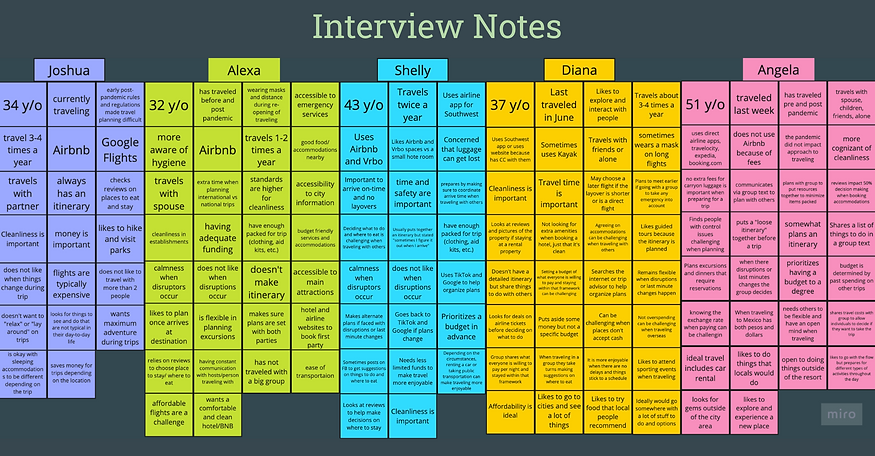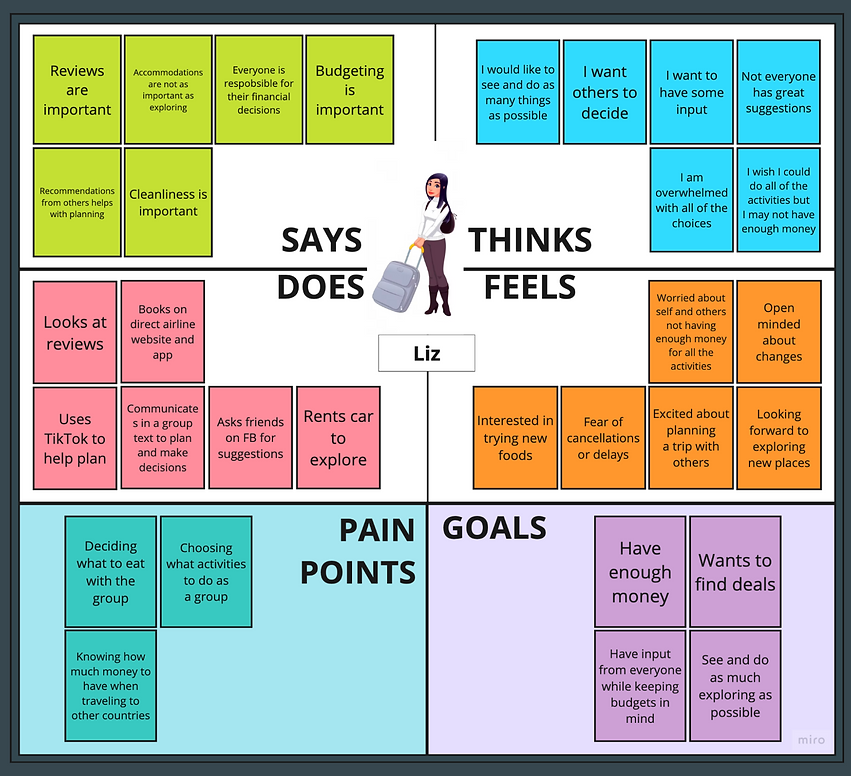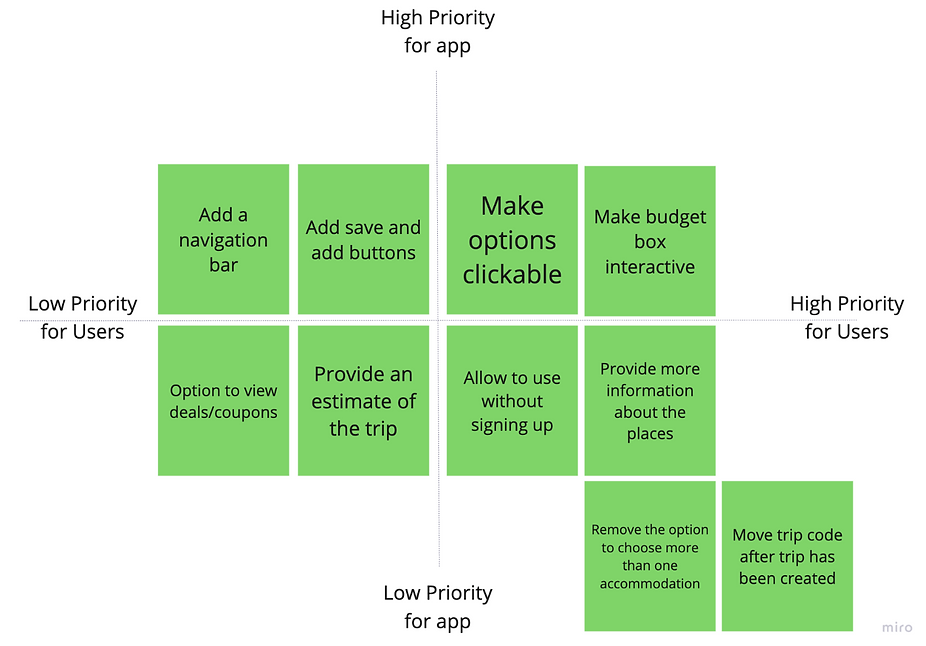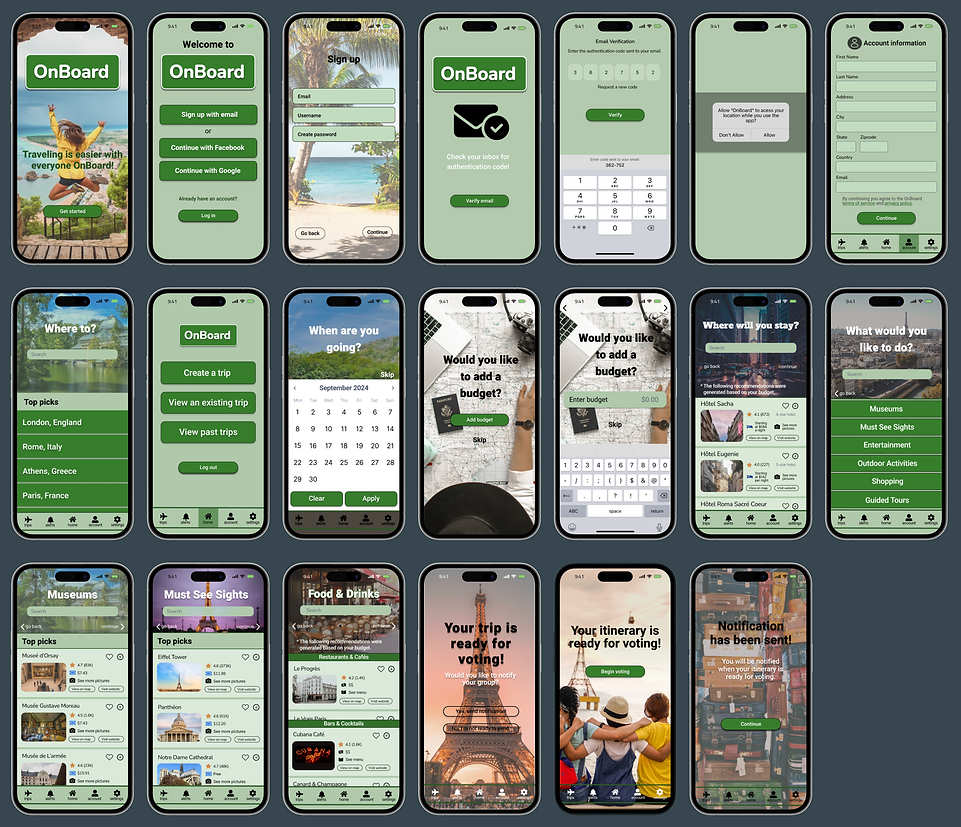OnBoard
Role: UX Researcher, UI Designer
Tools: Figma, Miro, Google
Timeline: 4 weeks
ABOUT ONBOARD
Onboard steps in to address the challenges of planning trips. The app is designed to foster collaboration, facilitate seamless sharing, streamline planning, and manage individual traveler's budgets, ensuring a smooth and enjoyable travel experience for all.
PROBLEM
Travelers need a seamless trip planning experiences with the ability to actively contribute ideas and engage in collaborative decision-making with their fellow travelers while managing individual and collective travel budgets.
SOLUTION
Create an app tailored for travelers to facilitate the planning of trips, whether with family, friends, or during solo adventures, with a focus on collaboration while being mindful of budget considerations.
Design Process

RESEARCH
User Research
5 22 15
Interviews Questions Minutes
Key objectives for our interviews:
-
What does the user need to make traveling more enjoyable?
-
How can we encourage adequate travel planning to people who face budget constraints?
-
What type of travelers use the app?
-
How can this product create a streamlined approach to traveling?
-
Can this app be used for more than travel planning?
Proto-Persona
In the initial stages of research for the OnBoard app, Andrea serves as the proto-persona, a 40-year-old professional who regularly embarks on travels with family, friends, and occasionally solo. Andrea's characteristics and travel habits provide valuable insights into the diverse user base that the OnBoard app seeks to accommodate. This proto-persona plays a crucial role in shaping the app's development, influencing the incorporation of features that cater to both group and solo travel experiences. By understanding Andrea's preferences, the OnBoard app aims to ensure a tailored and enjoyable experience for users with varied travel styles.

User Interviews
The user research phase began with five user interviews with participants that aligned with the proto-persona. This phase provided a better understanding of the target audience as well as played a important role in initiating the definition and ideation phase of the project.



Affinity Diagram
Following the interviews, I compiled all the notes and utilized the data to construct an affinity diagram. Systematically categorizing the information, I aimed to identify and comprehend the pain points, needs, and goals of travelers providing more detailed insight into their experiences.

Empathy Map
In exploring the user experience, I utilized an empathy map crafted from insights gathered through an affinity diagram. This approach enhanced my understanding of travelers' needs, frustrations, pain points, and goals, fostering a more empathetic and informed design process.

Theresa Roberts
User Persona
I created the user persona, Theresa Roberts, by combining the information derived from user interviews, the affinity diagram, and the empathy map. Theresa closely aligns with the proto-persona, incorporating insights from the research. Her preferences include the desire to manage a budget and actively collaborate with others in planning group trips.

Problem Definition
Problem Statement
Theresa faces challenges in achieving a seamless trip planning experience, struggling to collaborate on ideas and engage in collective decision-making with other travelers while managing individual and collective travel budgets.
User Insight
In response to these challenges, Theresa's pursuit of a seamless trip planning experience is fueled by the essential need for a platform that not only enables her to actively contribute ideas but also streamlines collaborative decision-making with fellow travelers. The critical element of managing both individual and collective travel budgets further emphasizes Theresa's need for a comprehensive and user-centric trip planning solution.
UX Hypothesis
To address these frustrations, I propose the development of an app designed to facilitate collaboration among a group of travelers, organizing itineraries while conscientiously considering budget constraints. This solution aims to provide meaningful assistance, reducing stress and enhancing the overall trip planning experience.
DEFINITION & IDEATION
Brainstorm
As I advanced to the next phase of the travel app project, the brainstorming stage played a key role in helping me generate innovative ideas and explore potential solutions. The outcomes from the brainstorming session allowed me to take those ideas and adopt a more organized approach with the feature prioritization matrix.

Feature Prioritization Matrix

Value Proposition
After crafting the feature prioritization matrix I went on to create the value proposition which helped define the unique benefits and advantages that set OnBoard apart in the competitive landscape. The value proposition emphasizes the app's features.

Competitor Analysis
In order to gain a better understanding of OnBoard's positioning in the travel app market, I conducted a thorough competitor analysis. The data I gathered offered valuable insights into competitors' features, advantages, strengths, and weaknesses further contributing to the ideation stage.

User Task Flow
The user task flow underwent three iterations. In my initial project experience, I was enthusiastic about incorporating numerous features, but eventually, I opted to concentrate on more specific elements to ensure a higher quality of work.



User Journey Map


Wireframe Sketches
To gain more definition and direction, I sketched paper wireframes. This, along witth rest of the steps in the definition and ideation phase, helped create a more defined path for the app.

PROTOTYPING
Digital Wireframes
I began the prototyping phase with low to mid fidelity digital wireframes to conduct usability testing before moving into the high fidelity screens. I then took the feedback I received and organized the data in a user test analysis to help with the iteration phase.

TESTING
Usability Testing
Usability testing provided user reactions and feedback, contributing to the iterative development of OnBoard. The feedback from the testing was collected and organized in the user test analysis where I examined user interactions and feedback to gain insights into the real-world usability of the app.
User Test Analyisis

Hi-fi Prototype


Thank you for viewing my case study!